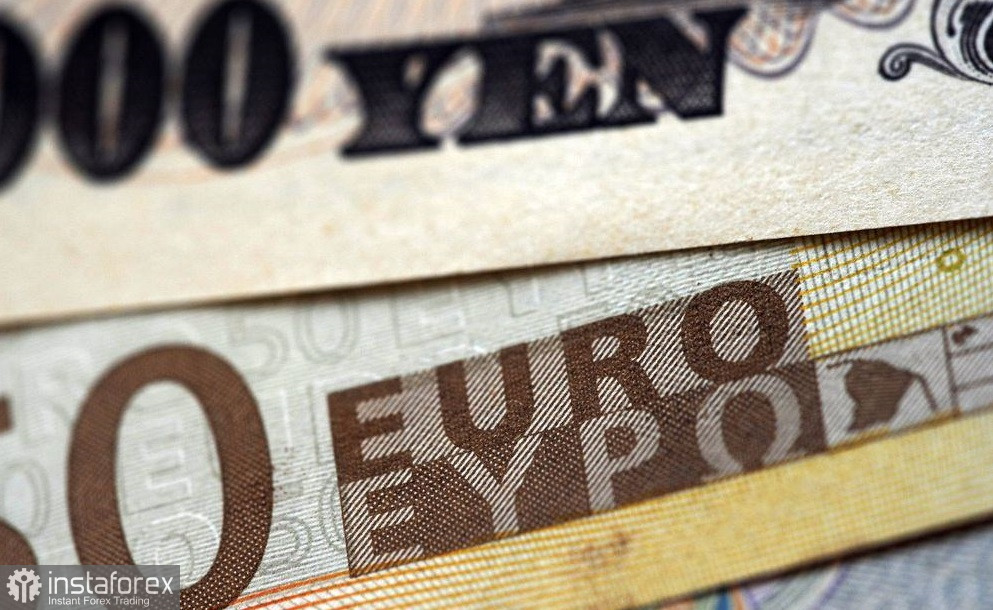The pair consistently displays a strong upward trend, setting new price records. Over the past three weeks of June, it has increased by more than 800 points. Minimal retracements accompany price growth as buyers quickly regain control and push the pair higher. The pair is approaching the 158 level, which marks a multi-year high. The last time it reached such levels was nearly 15 years ago, in September 2008. This price movement is driven by the simultaneous strengthening of the euro and the weakening of the yen.
Analyzing the monthly chart of EUR/JPY, we observe that the 135 level has long acted as a resistance point for any upward spikes and extended trends. Since 2015, buyers have been unable to surpass this level, except for short-term impulsive price surges. However, this situation changed in March 2022, marking the beginning of a significant upward trend for EUR/JPY. Over the past 15 months, the pair has risen by over 3,000 points. Hence, the aforementioned three-week surge is part of a broader global upward movement.

The primary driving force behind the pair's growth is likely the divergence in the European Central Bank (ECB) policies and the Bank of Japan. Last year, the ECB adopted a more hawkish stance, tightening its rhetoric and raising interest rates in July. In contrast, the Bank of Japan continued with accommodative monetary policies, remaining the only major central bank to maintain an ultra-easy monetary approach. Traders had expectations regarding Haruhiko Kuroda's successor, with potential candidates expressing hawkish positions over several months. However, the Japanese authorities chose Kazuo Ueda, who kept the monetary policy parameters unchanged. While Ueda mentioned the need for calibration, his statement had a more declarative tone. The new head of the Bank of Japan intends for changes to occur gradually and smoothly, utilizing the full 18-month policy review period declared. September-October expects the first verbal changes.
In this context, sellers of EUR/JPY have become disheartened. The recent inflation report, which revealed a slowdown in Japan, further added pressure on the yen. The overall consumer price index for May decreased to 3.2%, contrary to the anticipated growth of 4.1%. By comparison, the indicator stood at 4.3% year-on-year in January. The consumer price index, excluding fresh food prices, also exhibited a downward trend, slowing down to 3.2% in May compared to 3.4% in April.
These results allow the Japanese regulator to continue implementing an ultra-easy monetary policy without rushing to adjust its policy framework.
It is important to highlight that the most recent report on inflation growth in the eurozone indicated a concerning situation. However, the European Central Bank maintained its determined stance and intensified its hawkish language. For instance, Christine Lagarde effectively ensured an interest rate increase during the July meeting and hinted at further actions. Many analysts assess that the ECB will raise rates again in the fall and potentially at the December meeting.
Moreover, if the upcoming inflation reports at least meet the projected levels, and even more so if they enter the "green zone," the euro is expected to strengthen its position in the overall market, particularly against the yen. Tomorrow, on June 29th, inflation growth data for Germany will be released. It is anticipated that the annual consumer price index will rise to 6.3% (previously 6.1%), and the harmonized consumer price index (HICP) is projected to reach 6.7% (compared to the previous value of 6.3%).
The report on inflation growth in the eurozone will be published the following day, which is Friday. According to the forecasts of most experts, the core index, which excludes energy and food prices, should also demonstrate an upward trend, increasing to 5.5% from the previous value of 5.3%.
Therefore, despite the EUR/JPY pair reaching their highest prices in 15 years, there still needs to be more potential for further growth. The inflation reports scheduled for Thursday and Friday could contribute to the continuation of the upward trend.
Both fundamental and technical factors support long positions on the pair. On higher timeframes, such as H4 and above, the price either remains at the upper Bollinger Bands line or between the middle and upper lines. The Ichimoku indicator on the daily and weekly charts has also generated one of its strongest bullish signals, the "Parade of Lines." As a result, any corrective pullbacks could be utilized to open long positions, with the primary target set at 159.00, which represents the upper Bollinger Bands line on the D1 timeframe.
 English
English 
 Русский
Русский Bahasa Indonesia
Bahasa Indonesia Bahasa Malay
Bahasa Malay ไทย
ไทย Español
Español Deutsch
Deutsch Български
Български Français
Français Tiếng Việt
Tiếng Việt 中文
中文 বাংলা
বাংলা हिन्दी
हिन्दी Čeština
Čeština Українська
Українська Română
Română

